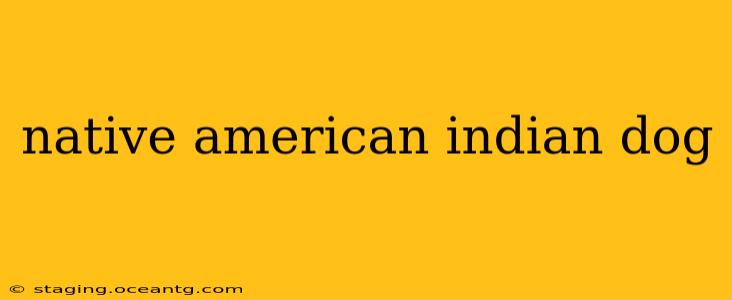Native American Indian dogs hold a rich and complex history, deeply intertwined with the cultures and survival of various Indigenous tribes across North America. These weren't simply pets; they were vital working partners, contributing significantly to hunting, herding, transportation, and even providing warmth and companionship. Understanding their history requires acknowledging the diversity of tribes and their unique relationships with their canine companions. This exploration delves into the breeds, their roles, and the ongoing efforts to preserve their legacy.
What Breeds of Dogs Did Native Americans Have?
This is a question often met with a simplified answer, and it’s crucial to understand the nuance. There wasn't a single "Native American Indian dog" breed. Instead, various tribes developed distinct canine types adapted to their specific environments and lifestyles. These dogs often exhibited a wide range of appearances, sizes, and temperaments, reflecting the diverse landscapes and cultural practices across the continent. Genetic studies are ongoing, offering increasingly detailed insights into the ancestral lineages of these dogs, revealing relationships with ancient breeds from Asia and the remarkable adaptations that occurred over centuries. Some of the more commonly discussed types include those resembling smaller, Spitz-like dogs, often agile and adept at hunting small game, and larger breeds used for pulling sleds or guarding. However, it is important to note that these are broad generalizations, and regional variations were significant.
Were Native American Dogs Used for Hunting?
Absolutely. Hunting was a cornerstone of many Native American cultures, and their dogs played a critical role. The dogs' specific roles varied depending on the prey and hunting techniques. Some were trained to flush out game, others to help bring down larger animals, while still others served as pack animals to carry the spoils of the hunt. The close collaboration between humans and dogs in hunting speaks to the deep-rooted bond and mutual reliance that characterized their relationship. Different dog types suited different hunting styles, demonstrating a level of canine specialization rarely seen elsewhere.
What Happened to Native American Dogs?
The arrival of European colonists brought devastating changes for Native American Indian dogs. The introduction of new diseases, warfare, and a shift in lifestyles led to a significant decline in their populations. Furthermore, the preference for European breeds often overshadowed the value and utility of Indigenous dogs. Many breeds were lost, their genetic lines fading into obscurity. However, efforts to preserve and revive these breeds are ongoing, combining historical research with modern genetic analysis. The challenge lies in piecing together fragmented history and ensuring ethical breeding practices to protect the unique genetic heritage of these dogs.
Are There Any Native American Dog Breeds Today?
While many distinct breeds were lost, some lineages survived. It is important to note that the term "breed" in this context requires careful consideration. The dogs that exist today claiming lineage to Native American dogs are often a result of ongoing efforts to preserve and recreate types. They might be considered "landraces" – populations of dogs that have adapted locally but haven't undergone the formal standardization processes of recognized kennel clubs. Understanding the history and genetic background of these dogs remains crucial, distinguishing them from more modern breeds.
How Can I Learn More About Native American Dogs?
Several avenues exist for expanding your knowledge. Researching specific tribes and their historical practices offers valuable insights into the roles dogs played within their cultures. Academic journals and books on archaeology and anthropology often contain details about canine remains and their significance. Museums and historical societies can offer artifacts and information about Indigenous canine companions. Finally, continued study of contemporary research into the genetics of Native American dogs continues to reveal new layers to this fascinating story.
This exploration offers only a glimpse into the complex relationship between Native Americans and their dogs. The diversity of breeds, their crucial roles in various societies, and their enduring legacy deserve continued study and appreciation. By understanding their history, we can better appreciate the profound connection between humans and dogs and work towards preserving the heritage of these remarkable animals.
